Dragonology 101
☄
A Look at the Most Common Dragon Species Today
We will be focusing on the five most common or well-known species in the Western world of dragons for this class. The following table lists them, as well ways to remember them.
| Species | How to Remember |
|---|---|
| draconis vulgaris abaculus cimeliarchae | The Treasure Keepers |
| draconis vulgaris xiphias monoceroti | Unicorn Dragon |
| draconis vulgaris hortus agricolai | Horticulturist Dragon |
| draconis vulgaris magnus | Mighty Dragon |
| draconis vulgaris tempus | Time-Keeper Dragon |
draconis vulgaris abaculus cimeliarchae
The Treasure Keepers
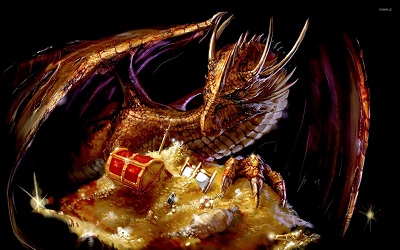
Click image for larger view.
This is the most commonly known dragon by stereotype only. Most people are under the assumption that all dragons hoard treasure, this is simply not true. Treasure Keeper dragons make up a very small proportion of dragon society, a mere 5% overall.
Another common misconception is they only hoard treasure, that is, a human perception of what is treasure, such as precious gems and metals. They also collect anything that they find pretty, such as glass, crystals, semi-precious stones, etc…. Above all, they are simply attracted to shiny objects. One such object is a simple human dressing mirror. This has also led to the perception that all dragons are self-absorbed and narcissistic, which again, couldn’t be further from the truth.
Treasure Keeper dragons are somewhat like the bankers of Dragon society. Dragons of other species will store their wealth with Treasure Keeper dragons for safekeeping. They are lovely, shy and reclusive beings that have historically tried to steer clear of all humans.
It was unfortunate, though, when humans discovered that Treasure Keeper dragons had wealth and treasure beyond imagination and tried to steal it. Treasure Keeper dragons maybe shy but have no qualms about protecting their hoard, as it also contains the wealth of others depending upon them to keep it safe. Many, many humans have been roasted alive trying to obtain dragon treasure.
As humans became wise to the this, Treasure Keeper dragons suffered immensely, as human attackers arrived better prepared and armed to get what they wanted. This is when the population of the Treasure Keeper dragon started to drop dramatically. By the time of the 1540 Council of Chartres, they had experienced a 95% reduction in their numbers, the worst of all the dragon species.
When they relocated to the parallel world, they only made up a meagre 1% of the full dragon population. Their numbers are coming back up, but, sadly, not as much as we would like to see. Another tragedy for them was just how much of the treasure that was put in their safe-keeping had been lost, never to be recovered. Being quite sensitive beings, this still bothers them to this day, even though the rest of the dragon community have thoroughly forgiven them over and over, even telling them that it really is of no consequence. After all, treasure is really only precious to Treasure keeper dragons.
Fully-grown Treasure Keeper dragons are the smallest dragons, on four legs they only stand as tall as a two to three-storied building. Standing on their hind legs, with wings outstretched they rise to about five stories and weigh around two tons, or around 4,000 lbs. and generally have a lifespan of 8,500 years.
draconis vulgaris xiphias monoceroti
Unicorn Dragon

Click image for larger view.
Unicorn dragon was named for the single horn springing from its snout. A proud and regal being, who has been a loyal protector and advocate for human-kind almost since the very beginning of human-kind. Unicorn dragons fought to bring the gift of fire to early humans, where the rest of Dragon society were very much against it, thinking it too dangerous a gift for such a fledgling civilization. Unicorn dragons finally prevailed, persuading the rest of the dragon community to share the gift of fire.
Unicorn dragons took the most interest in humankind, taking them under their wings so to speak… Unicorn dragons showed humans the best caves to live in, as well as how to use the new gift of fire for cooking, warmth, and protection.
Unicorn dragons taught humans how to hunt and trap, and how to use the hide and furs for clothing. Unicorn dragons also showed humans how to make tools and where to find the earth pigments to make the paintings on their cave walls.
When the rest of the Dragon community did not want much to do with humans, Unicorn dragons were very much there for humna-kind, teaching us everything we needed to know to survive, that is, until we got interesting enough for the other dragons to take notice…
Fully-grown Unicorn dragons on four legs stand as tall as a four-storied building. Standing on their hind legs, with wings outstretched they rise to about six stories and weigh around four tons, or around 8,000 lbs. and generally have a lifespan of 8,500 years.
draconis vulgaris hortus agricolai
Horticulturist Dragon

Click image for larger view.
Horticulturist dragons, or “Horties” as they are most affectionately called, are another lovely and gentle species of dragons. They were the first species after Unicorn dragons to begin to take an interest and began interacting with and assisting humans. Horties taught humans how to more efficiently forage for food and also how to cultivate food on a small scale to supplement their hunting and trapping practices. They also taught humans how to heal themselves with plant medicines. Horties were the first Potions Professors in wizarding schools. All of the best Potions Masters learned from Horties directly.
As early humans were nomadic, following the herds, Horties taught them how to plant small patches of food that required little effort and would be ready to harvest as they circled back a few months later. Horties did not teach man about modern agriculture, as it is so detrimental to the environment. What Horties taught was an early form of what is know today as Permaculture.
Once human-kind mastered the skills of hunting, gathering, and small scale food cultivation, they found they had so much more leisure time. Humans were able to spend more time creating art and music, developing their spiritual practices and playing games, telling stories, and having a good time with family and friends.
Fully-grown Horticulturist dragons on four legs stand as tall as a five to six-storied building. Standing on their hind legs, with wings outstretched they rise to about seven stories and weigh around five to six tons, or around 10-12,000 lbs. and generally have a lifespan of 8,500 years.
draconis vulgaris magnus
Mighty Dragon
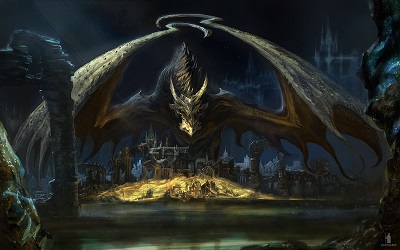
Click image for larger view.
Magnus dragons are the natural leaders of the dragon world, not only due to their impressive size, but also their keen intellect. Magnus dragons love learning anything and everything. Their natural curiosity of the physical world has given us the basis for the all physical sciences. They have so much more to share with humanity, but of course that had to stop after the 1540 Council of Chartres and their relocation. Magnus dragons have also refused to continue to share their advanced knowledge with the wizarding community, so as to not give them any more advantages over the non-wizarding community.
Much of our higher knowledge of most disciplines come from Magnus dragons, from the physical sciences, to mathematics, philosophy, and art. Our modern governments are even loosely modeled after dragon governments developed by Magnus dragons. Magnus dragons also live the longest of all dragon species, the oldest living Magnus dragon today is well over 10,000 years old. I can hardly begin to imagine the amount of knowledge one could acquire over such an immense period of time!
Magnus dragons are great teachers, in the early days of this wizarding school and many others like it, Magnus dragons served as professors and headmasters. The best witches and wizards are ones that were taught by Magnus dragons. If you ever get a chance to have a chat with a Magnus dragon, I highly recommend you take it, you won’t be disappointed. Don’t worry if you think you can’t keep up with their intellect, Magnus dragons are very sensitive to this and will make sure you can understand without making you feel like a prat. Magnus dragons are quite magnanimous indeed!
Fully-grown Magnus dragons are the largest dragons, on four legs they stand as tall as a nine-storied building. Standing on their hind legs, with wings outstretched they rise upwards to twelve stories and sometimes beyond, and weigh around ten tons, or around 20,000 lbs. and generally have a lifespan of 10,000 years.
draconis vulgaris tempus
Time-Keeper Dragon
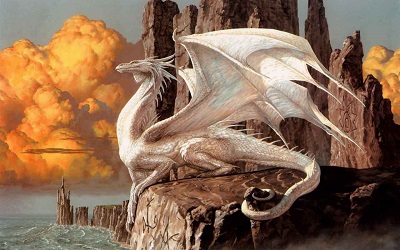
Click image for larger view.
Tempus dragons are the Time-Keeper dragons, or the historian dragons. Like Magnus dragons, their lifespan is also quite lengthy. The oldest living Tempus dragon just turned 10,000 years old, which is 500 years more than their generally accepted life expectancy of 9,500 years. There are also a few other Tempus dragons that have already passed 9,500 marker with no indications of stopping, we are hoping this is a trend!
Tempus dragons are the history keepers, everything we know of ancient earth and early human history, before humans started keeping records (under the tutelage of Tempus dragons of course!) is from them. They have been not only recording their own illustrious history, but also that of human history as well, both wizarding and non-wizarding alike.
Tempus dragons taught early humans structured language and rudimentary writing. They brought us the early runic alphabet for this purpose.
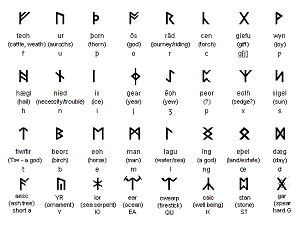
Click for larger view.
As our abilities grew, they taught us more refined language and writing skills. They taught us the art of poetry and prose, as well academic and technical writing. They served as highly esteemed professors in many wizarding schools around the world. It is a well-known fact in the wizarding world that William Shakespeare was taught by dragons!
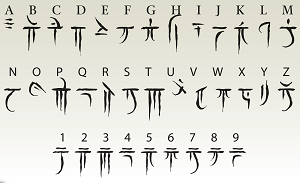
Click image for larger view.
You can see how Babylonian cuneiform started to split here from early draconic forms. They actually seemed to regress, in my opinion!
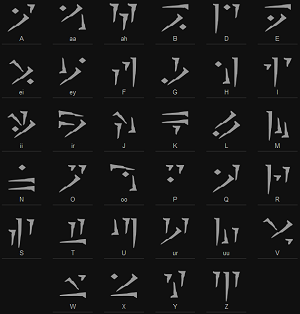
Click image image for larger view.
Here is an example of Modern Draconic Script. Quite elegant, isn't it?

Click image for larger view.
Fully-grown Tempus dragons on four legs stand as tall as a seven-storied building. Standing on their hind legs, with wings outstretched they rise to about ten stories and weigh in around eight tons, or around 16,000 lbs. and generally have a lifespan of 9,500 years.
☄
Please move on to the next module, Physiology and Psychology